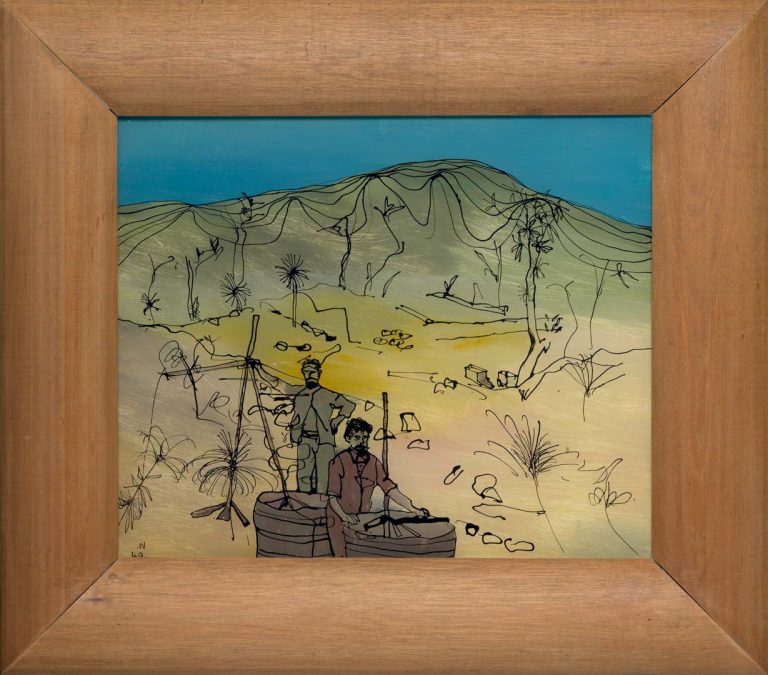We acknowledge the Traditional Owners of the land on which the Queensland Art Gallery | Gallery of Modern Art stands and recognise the creative contribution First Australians make to the art and culture of this country.

Sidney Nolan / Australia/England 1917–92 / Puddling 1949 / Brush and Indian ink and Ripolin enamel on glass / 25.4 x 30.5cm / Gift of the Godfrey Rivers Trust 1949 / Collection: Queensland Art Gallery / © Courtesy of the Artist’s Estate/www.bridgeman.co.uk
Sidney NolanPuddling 1949
Not Currently on Display
Sidney Nolan’s ‘Eureka Stockade’ series was inspired by Raffaelo Carboni’s famous eyewitness account of the 1854 uprising on the Victorian goldfields. Written in 1855, Carboni’s book held the same attraction for Nolan as Thomas Keneally’s book on the infamous Kelly family. It is an idiosyncratic first-person narrative ranging from exuberant rhetoric to sarcasm to disarming innocence.
Of the ‘Eureka Stockade’ works Nolan said: ‘I read Raffaelo Carboni’s book on the rebellion and I took what he said as gospel. I did not try to do a large, historical summing up, but I did it as I read it in the book. They are, so to speak, one-off snapshots of each episode and of the “dramatis personae”.’
To create the series of about sixty miniatures, Nolan worked first with Indian ink on the reverse of the glass sheets. These drawings — reminiscent of colonial engraved illustrations — were then painted over in enamel, again on the reverse to create a wonderfully translucent effect.
Endnotes:
Edited extract from Jane Clark, Sidney Nolan, landscapes and legends: A retrospective exhibition 1937–1987 [exhibition catalogue], National Gallery of Victoria, 1988, p.104.
Born in 1917, Sidney Nolan lived with his family in an Irish-Australian enclave in Melbourne. After leaving school, he began a part-time art correspondence course, and in 1934, he attended evening drawing classes at the National Gallery of Victoria Art School.
Nolan believed that the emotional potency of mythology can add resonance to the facts of history. Across his body of work, he experimented with size and technique, returning to the formal task of positioning a focal subject within a context and in front of a background.
His first solo exhibition, a series of abstracts and collages, was held in 1940. Between 1942 and 1945, Nolan served in the Australian Army, guarding stores in western Victoria, where he began painting outback landscapes.
He first depicted bushranger Ned Kelly in early 1945. The following year, he was discharged in absentia after failing to return to service following a month’s leave. Nolan ventured to Queensland in July 1947, spending several weeks visiting Brisbane and Fraser Island.
In 1950, he left for England, and in 1957, he was recognised with a retrospective at London’s Whitechapel Gallery. Nolan had more than 70 solo exhibitions and was knighted in 1981.